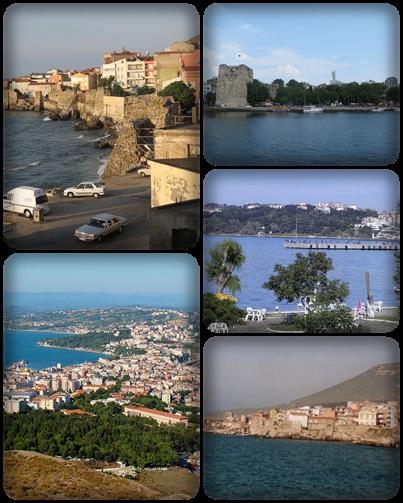Sinop
Sinop
 Sinop is very enjoyable, calm, ok. 30-town with a thousandth population, picturesquely situated by a beautiful bay. Part of the city is surrounded by ancient walls that sometimes go straight to the sea. Admittedly, Sinop is not on any important hiking trail, however, recently there has been a significant increase in the number of foreigners during the season, because the town is appreciated by them as an oasis of peace compared to the bustling Samsun or even the Trabzon.
Sinop is very enjoyable, calm, ok. 30-town with a thousandth population, picturesquely situated by a beautiful bay. Part of the city is surrounded by ancient walls that sometimes go straight to the sea. Admittedly, Sinop is not on any important hiking trail, however, recently there has been a significant increase in the number of foreigners during the season, because the town is appreciated by them as an oasis of peace compared to the bustling Samsun or even the Trabzon.
Tourists, who want a peaceful vacation on the Black Sea coast, they choose Sinop more and more often, successfully competing with Amasra, located closer to Istanbul.
History
Archaeological finds have proven existence in the vicinity of Sinopu over 30 prehistoric settlements, the earliest of which dates back to 4500 lat p.n.e. Sinop itself was founded by Greek colonists from Miletus in the 7th century. p.n.e. and some scientists say, that it may have been the oldest Greek city on the Black Sea coast. In turn, Sinop established several other colonies by this sea, m in. Samsun or Trabzon, who paid him tribute. Soon Synopa (name in Polish) became one of the most important trading centers in the region controlling the other Black Sea colonies (also those in Crimea). She maintained independence until 183 r. p.n.e., when King Pontus Famaces I seized them. Because the location of Sinope was very convenient, it soon became the capital of the Pontic state (the capital was moved here from Amasya). The most famous Pontic king Mithridates VI Eupator was born here, and his war with Rome led to the destruction of the city by the Roman army led by Lucullus (70 p.n.e.) and the mighty fortifications he had built before were of no avail. Rebuilt Synopa for the next four centuries belonged to the Roman Empire and was developing successfully within it, happily having the status of a free city. In Byzantine times, it was an important center of trade between Crimea and Asia Minor. After the capture of Constantinople by the Crusaders (1204) Manuel I Comnenus took over the city, but he soon enjoyed his new property, because after 10 The Seljuqs came here for years, winning Sinope (1265). In the following years, the emperors of the kingdom of Trapezuntu tried to recapture it in an alliance with Genoese merchants., but their efforts failed. From the mid-fourteenth century. the emirs of Kastamon ruled in Sinop, which in 1391 r. he defeated Bejazid I Błyskawica. Then they moved the capital from Kastamon to Sinope and stayed here until 1461 r., that is, the conquest of the city and the defeat of the emirate of Kastamonu by Mehmed II. From then on, the city was in the hands of the Ottomans. Among the more interesting episodes, it is worth paying attention to the fact that the city was plundered by the Cossacks in 1. half. 17th century. and the unexpected attack of the Russians in 1853 r., who started the Crimean War.
The famous Greek philosopher Diogenes was born in ancient Synopia (ok. 413 – 323 p.n.e.), teaching the science of renouncing all material goods and living in accordance with nature. He became famous, among others. of this, that he lived in a barrel, and with the answer, which he gave to Alexander the Great when asked, what he wishes. Then he said bluntly, that the questioner would reveal to him the sun, because he doesn't need anything else.
Places, which are worth seeing
In Sinopa, you can see magnificent fortifications and ancient mines in the form of the temple of Serapis, as well as several monuments from the Turkish era. It shouldn't take more than half a day. During breaks, we can swim in the sea and enjoy the sun on the nearby beaches.
Sinop Muzesi (Sinopu Museum) is open every day (except Mondays) in hours. 8.00 – 17.00, introduction: 0,7 USD, students: 0,35 USD. (It was closed while the guide was being written, but maybe in the summer 2003 r. will be open now; the curator complains about the lack of renovation funds). Situated at the back of the town hall, near the main square, the museum has collected interesting exhibits from the Hittite times (vases etc.), Greek and Roman (ceramics and glass). Orthodox icons from the 18th and 19th centuries are interesting. On the territory of the museum there are ancient ruins in the form of foundations and several columns of the Serapis temple, probably created in the 2nd century. p.n.e. It was built on a rectangular plan (9x 15 m) with an altar on the eastern side. Iconic statues of Serapis were found on its site (greco-egyptian god, whose cult spread in Egypt during the reign of Ptolemy, and later reached Greece), They are, Dionysus, Persephone is Heracles, as well as ceramics and architectural elements.